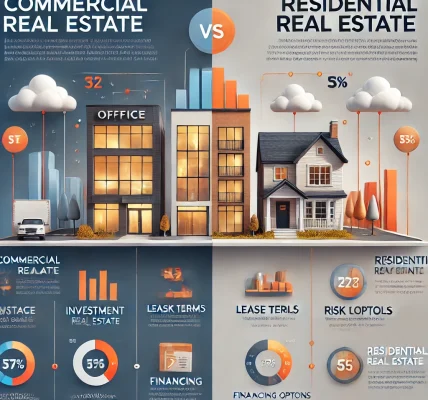Introduction
Interest rates play a crucial role in shaping the real estate market. Whether you’re an experienced investor or a first-time buyer, understanding how interest rates affect property values, mortgage costs, and overall investment returns is essential. The relationship between interest rates and real estate investments can determine market trends, investment strategies, and financial outcomes.
This guide will explain how interest rate fluctuations impact real estate investments, key factors to consider, and strategies to mitigate risks while maximizing returns.
1. Understanding Interest Rates in Real Estate
Interest rates represent the cost of borrowing money and are set by central banks (such as the Federal Reserve in the U.S.). They influence mortgage rates, investment financing, and overall market demand.
Types of Interest Rates in Real Estate
- Fixed Interest Rates: Remain the same for the loan duration, providing stability and predictability.
- Variable (Adjustable) Interest Rates: Fluctuate based on market conditions, which can lower or increase borrowing costs over time.
- Prime Rate: The rate banks charge their most creditworthy borrowers, affecting overall lending rates in the economy.
2. How Interest Rates Impact Real Estate Investments
Interest rates affect real estate investments in multiple ways, from mortgage affordability to property appreciation and rental yields.
a) Mortgage Costs and Affordability
📉 Higher Interest Rates → More Expensive Loans
- Higher rates increase monthly mortgage payments, reducing affordability for buyers.
- Investors may need higher down payments to qualify for loans.
📈 Lower Interest Rates → Cheaper Borrowing
- Lower rates make mortgages more affordable, increasing property demand.
- Investors can secure larger loans with the same monthly payments.
b) Property Values and Market Demand
- High Interest Rates → Decreased buyer demand, slower property appreciation, and potential price corrections.
- Low Interest Rates → Increased home purchases, competitive bidding, and property value growth.
c) Rental Market Dynamics
- When rates rise, homeownership becomes expensive, increasing rental demand and allowing landlords to raise rent prices.
- When rates fall, more people buy homes, reducing rental demand but increasing property resale value.
d) Investment Returns and Cash Flow
- Higher borrowing costs can reduce net rental income and investment returns.
- Investors must factor in interest rate changes when calculating ROI (Return on Investment).
3. Historical Trends: How Interest Rates Have Shaped Real Estate Markets
Examining past interest rate trends provides valuable insights for investors.
Case Study: U.S. Real Estate Market Trends
📅 2008 Financial Crisis: Interest rates were lowered to stimulate housing demand after the market collapse. 📅 2020 Pandemic Response: The Federal Reserve dropped rates to historic lows, triggering a real estate boom. 📅 2022-2023 Rate Hikes: Rapid rate increases cooled down housing markets and slowed investment activity.
Key Takeaway: Investors should monitor central bank policies and anticipate how interest rate changes might affect future property values and investment opportunities.
4. Strategies to Mitigate Interest Rate Risks
Interest rate fluctuations are inevitable, but investors can adopt smart strategies to protect their investments and maximize returns.
a) Choose Fixed-Rate Mortgages for Stability
- Protects against sudden rate hikes.
- Ensures consistent payments and predictable cash flow.
b) Leverage Adjustable-Rate Mortgages (ARMs) Wisely
- If rates are high, consider ARMs with lower initial interest rates.
- Beneficial if you plan to sell or refinance before rate adjustments.
c) Focus on High-Demand Rental Markets
- Invest in areas with strong job growth, population increase, and rental demand.
- High rental demand helps offset higher financing costs.
d) Refinance When Interest Rates Drop
- If rates decrease, refinancing can reduce monthly payments and improve cash flow.
- Look for opportunities to shorten loan terms and build equity faster.
e) Diversify Real Estate Investment Portfolio
- Consider investing in different property types (e.g., residential, commercial, REITs).
- Reduces risk exposure to market shifts caused by rate changes.
5. What Investors Should Do in Different Rate Environments
| Interest Rate Condition | Investor Strategy |
|---|---|
| Rising Rates 🚀 | Focus on cash-flow-positive properties, use fixed-rate loans, increase rental income. |
| Falling Rates 📉 | Refinance existing loans, expand investments, buy undervalued properties. |
| Stable Rates ⚖ | Maintain investments, monitor economic trends, optimize portfolio returns. |
6. Final Thoughts: Interest Rate Awareness for Smarter Investing
Interest rates are a critical factor in real estate investing, affecting mortgage costs, property values, rental demand, and overall returns. Smart investors continuously monitor rate trends, adapt strategies, and optimize portfolios to mitigate risks and maximize gains.
Key Takeaways
✅ Understand how rate changes affect property financing and investment returns. ✅ Use fixed-rate mortgages for stability in high-rate environments. ✅ Leverage refinancing and investment timing to capitalize on rate drops. ✅ Invest in high-demand rental markets to offset borrowing costs. ✅ Stay informed on economic policies and central bank decisions.




